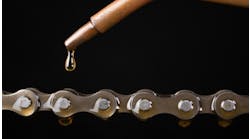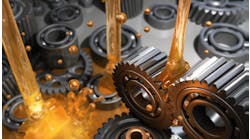Lubrication is necessary to keep machinery moving. But what keeps the lubrication moving?
Automatic application is a way to guarantee that things that move, turn, slide, etc., in a plant get the lubrication they need, constantly and reliably. It can assure that the right kind of lube gets applied in just the right amount, with none of the problems associated with over- or under-application.
Many automatic lubrication devices are decidedly low-tech affairs, like oil bulbs, that have been around for a long time. But some use sophisticated digital technology to match the needs of the equipment they're servicing at any given moment.
This automated system lubricates the chain on a spiral bread cooler. Photo: Motion Industries
The biggest reason to invest in automatic lubrication is to improve equipment life. Inadequate lubrication is one of the leading causes of equipment failure. It takes only one such failure, at a crucial point like a conveyor bearing, to cripple a line.
“The ultimate advantage to automatic application is the cost savings,” says Ian Miller, national services business development manager for Motion Industries Canada. “Having an [automatic lubrication system] can offer savings through extending the life of the equipment being serviced (through optimization of the lubricant application), freeing up skilled labor and the savings that typically result from reducing the amount of lubricant being consumed.”
Automatic lubrication avoids other problems that can arise from human error: missing a spot (or several), using the wrong lubricant or over-lubricating. The last is often a pitfall, says Kurt Rommelfaenger, sales and marketing manager for Oil-Rite Corp.
“I think when you’re talking food industry, we always talk to customers about contamination and the risk of over-lubricating and having lubricant either get onto the packaging or onto the food itself,” Rommelfaenger says.
Keeping things running
The best candidates for automatic lubrication are points in equipment that runs continuously, or almost continuously, to a degree that would lead to failure with even a momentary lapse in lubrication. This includes bearings for conveyors, motors, fans and blowers, and pumps; bearings on other equipment, such as mixers, agitators, extruders and fillers; gearboxes and chain lubrication for conveyors, and more.
Automatic oilers vary as much in their design and operation as the equipment they service. Operational principles include oil drip, restricted flow, spraying, gravity feed and more.
Perhaps the most basic distinction in lubrication is whether the target is fixed or moving. The latter usually means a conveyor chain, and a common method for lubrication is spraying. One way to ensure that a chain gets exactly as much lubrication as it needs, and no more, is to use electrostatic application.
As the oil is atomized emerging from the sprayer, it receives a negative charge that coats the surface of each droplet with electrons. The chain serves as a positive anode, attracting the negatively charged droplets and ensuring that the chain gets thoroughly coated without any excess oil falling off.
Another method for chain lubrication is a sprocket-shaped applicator from Timken (www.timken.com) called the Rotalube. It features 24 small injector holes that deposit oil directly onto links and pins, and can be programmed to vary the amount as needed.
As for fixed targets, these are always rotating machine parts, like bearings or gears. If the parts are in an enclosure that can contain excess lubrication, like a gearbox, then automatic lubrication is a simple matter of maintaining the level of lubricant in an attached tank. Other applications are trickier.
If lubrication has to be delivered in varying doses to different points in a machine or to a cluster of points on a line, a common method is a divider block. This is a device, usually a metal box, that accepts an inflow of lubricant and divides it among an array of ports on three sides of the box. Those are connected to small cylinder pumps or other injectors that deposit the lubricant as needed.
This sort of centralized system is common, but decentralized ones are available. These are sometimes the best option for maintaining lubrication in the interior of a complex machine, especially one that runs nonstop or nearly so. These systems can be fitted by the equipment manufacturer or retrofitted by the end user into machinery to keep it constantly lubricated.
This four-feed motorized grease PurgeX dispenses once per minute and requires no more than a power source to operate.
One such system is Oil-Rite’s PurgeX, a small (4 inches tall) piston pump that can be attached anywhere inside a machine and fed through a small, flexible tube. For tighter spaces, an Ultra-Micro PurgeX is available that delivers one-tenth the dose of the larger model.
Just enough
Keeping parts free of excess lubrication requires judicious application. Technology can help.
Arguably the greatest recent advancements in automatic lubrication have to do with control systems. By synching with the actual speed of the equipment, digital controls allow devices to deliver lubrication in the amount needed, when it’s needed.
“Although many advancements are being made in the mechanical equipment used for auto lubrication, the greatest advancements in recent years have been in the control systems,” Miller says.
Most applicators that propel lubricant, like piston-fed sprayers, operate with compressed air. But, as with many types of industrial equipment, digital operation is taking hold.
“Historically, spray systems were pneumatically driven, but recent advancements in this technology have led to newer ‘airless’ systems increasing in popularity,” Miller says.
Lubrication applicators are available that have the same digital capabilities as other equipment: to receive data about the machinery they’re servicing and adjust their doses accordingly.
That can be useful in applications like a conveyor that runs at varying speeds, Rommelfaenger says. The conveyor’s controller signals the applicator to increase or decrease the amount of lubrication as the speed changes. This can be done with electronics provided by Oil-Rite to be integrated into the end user’s system, or the pump can be integrated into an existing data and control system.
Since the device uses just an on/off signal, it’s relatively easy to hook up, Rommelfaenger says. “Even though it can achieve precision, it doesn’t require a whole lot of technical savvy to make it happen.”
Using the IIoT
The industrial internet of things (IIoT) has the potential to take lubrication automation to the next level. As with other applications, the IIoT gives a lubrication device the capability to communicate its condition, or the condition of the contact point it’s oiling, to a central server, which can then send a notification or take other action.
Devices that dispense lubricants can ensure that bearings and other critical points in a plant never run dry. Photo: Lubriplate/Perma
Perma, a supplier that has a distribution agreement with Lubriplate, is scheduled to come out with a line of lubricators that use Bluetooth technology, says Scott Besedick, Lubriplate district manager, although no further details were available at press time.
“I think they will also be addressing the market need for a larger reservoir to handle larger size bearings and lubricators that generate greater pressure for longer remote mounting capability,” Besedick adds.
As with many applications of automation, a gradual approach might be worthwhile. That makes for an easier investment, while still maintaining the advantage of being able to avoid human error in lubrication, Miller says.
“The best example is installing a series progressive block to service multiple points but using a manual grease gun to operate the block,” Miller says. “This can allow for a savings in capital outlay while still ensuring all points are properly serviced.”
In any case, he says, early investment in lubrication automation will pay off.
“The days of timers and relays is quickly disappearing, and the ability to integrate your plant-wide control system with condition monitoring equipment to enable real-time adjustment of lubricant application is becoming a reality,” he says. “As machine learning and AI start to permeate our industry, those who invest in these technologies will be the ones to reap the rewards.”


